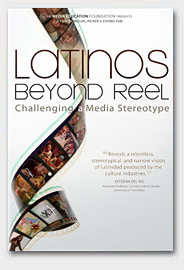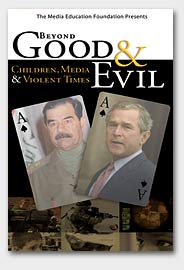Latinos Beyond Reel: Challenging a Media Stereotype
Latinos are the fastest-growing segment of the U.S. population, and among the most diverse -- accounting for one-sixth of all Americans and tracing their origins to more than 20 countries. They are also a rising force in American politics. Yet across the American media landscape, from the broadcast airwaves to cable television and Hollywood film, the reality and richness of the Latino experience are virtually nowhere to be found. In Latinos Beyond Reel, filmmakers Miguel Picker and Chyng Sun examine how US news and entertainment media portray -- and do not portray -- Latinos. Drawing on the insights of Latino scholars, journalists, community leaders, actors, directors, and producers, they uncover a pattern of gross misrepresentation and gross under-representation -- a world in which Latinos tend to appear, if at all, as gangsters and Mexican bandits, harlots and prostitutes, drug dealers and welfare-leeching illegals. The film challenges viewers to think critically about the wide-ranging effects of these media stereotypes, and to envision alternative representations and models of production more capable of capturing the humanity and diversity of real Latinos. Features commentary from Charles Berg, Otto Santa Ana, Angharad Valdivia, Federico Subervi, Mari Castaneda, Chon Noriega, Isabel Molina, Alex Nogales, Juan Gonzalez, Moctesuma Esparza, Josefina Lopez, Alex Rivera, Luis Ramos, Lisa Vidal, and others. DVD contains two versions: a full length version (84 minutes) and an abridged version (61 minutes). Sections: Introduction | Invisible and Vilified | Who Tells Our Stories? | Justifying History | Stereotypes Never Die? | Images Matter.
The Price of Pleasure: Pornography, Sexuality, and Relationships
Once relegated to the margins of society, pornography has become one of the most visible and profitable sectors of the cultural industries in the United States. It is estimated that the pornography industry's annual revenue has reached $13 billion. At the same time, the content of pornography has become more aggressive, more overtly sexist and racist.
The film features the voices of consumers, critics, and pornography producers and performers. It is particularly revealing when male pornographers openly discuss their views about women and how men should relate to them, and when male and female porn users candidly discuss the role pornography has played in shaping their sexual imaginations and relationships. The film paints both a nuanced and complex portrait of how pleasure and pain, commerce and power, and liberty and responsibility are intertwined in the most intimate aspects of human relations. At the same time, the film examines the unprecedented role that commercial pornography now occupies in U.S. popular culture. Going beyond the debate of liberal versus conservative so common in the culture, The Price of Pleasure provides a holistic understanding of pornography as it debunks common myths about the genre.
The film features interviews with scholars of mass media (Gail Dines and Robert Jensen), economics (Richard Wolff), and psychology (Dr. Ana Bridges); writers on pornography and popular culture (Ariel Levy and Pamela Paul); producers and performers from the pornography industry (John Stagliano, Joanna Angel and Ernest Greene); and a former stripper/porn performer-turned-author (Sarah Katherine Lewis).
Please visit the website (www.thepriceofpleasure.com) for clips and information.
The Price of Pleasure is distributed by Media Education Foundation.
Mickey Mouse Monopoly: Disney, Childhood & Corporate Power
Chyng Sun was born and raised in Taiwan, where she Chyng Sun was a journalist for a daily newspaper and received numerous national awards for her books for children. After coming to Boston in 1989, Sun continued to publishing write children’s books, and the titles including (all by Houghton Mifflin Co.): Square Beak, On a White Pebble Hill, Mama’s Bear, Cat and Cat-face, etc., all published by Houghton Mifflin. Sun received a master’s degrees in education ((Syracuse University)), and a maser’s degree in children’s literature (Simmons College, Boston), and a Ph.D. in communication (University of Massachusetts, in Amherst). She is currently a Clinical Associate Professor of Media Studies (School of Continuing and Professional Studies) at New York University. Her research, teaching, and writing are centered on media representations of race, class, gender, and sexuality, and their cultural and social impacts. Since 2004, Sun’s research has focuseds on the production, content, and effects of pornography. Currently, Sshe is currently the designer and leader for a multinational research team of a global research project on studying pornography users.
Sun is also a documentary filmmaker who, in collaboration with Miguel Picker, has produced and written four documentary films (see Picker’s bio above).
Beyond Good & Evil: Children, Media & Violent Times
The belief that "good triumphs over evil" resonates deeply in our psyche through religious, cultural, and political discourses. It is also a common theme in the entertainment media where the struggle between good and evil is frequently resolved through violence. The potential negative impact of media violence on children has long been a public concern. It is even more troubling when U.S. military violence, both in the news and in the entertainment, is often glorified as heroic and patriotic.
Children's worlds of fantasy and reality collided when our political leaders, in response to the September 11th tragedy, simplified the complex international relationships into a fight between good and evil. The Bush administration used the narrative strategically and the news media perpetuated it with enthusiasm pumping up patriotism and generating public support for the invasions of Afghanistan and Iraq.
This video examines how the "good and evil" rhetoric, in both the entertainment and the news media, has helped children to dehumanize the enemies, justify their killing and treat the suffering of innocent civilians as necessary sacrifice. Featuring commentary from media scholars (Robert Jensen, Robin Andersen), child psychologists (Diane Levin, Nancy Carlsson-Paige), teachers (Merrie Najimy, Brian Wright), educators (Eli Newberger and Betty Burkes), and children.
Sections: Intro: Where Were You? | A Simple Story | Playing at War | Constructing the Enemy





